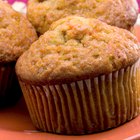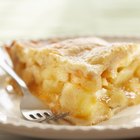While you wouldn't want to bake a cake with only konjac flour, it can play an important role in baking as a gluten-free thickening product. Konjac flour, or konjac gum as is also called, has up to 10 times the viscosity of cornstarch, yet does not contain starch or sugar and has no calories. Use konjac flour along with whole-wheat flour to improve the texture of baked goods or put it to use to thicken pies, puddings and cakes.
Konjac Basics
Konjac flour is derived from the konjac plant, a native species of the subtropical and tropical regions of eastern Asia. Konjac is most commonly used in making Japanese favorites shirataki noodles and konnyaku, but is also used as a thickener in both cooking and baking both in the Japanese kitchen and elsewhere. The flour of the konjac plant is high in fiber and low in fat and serves as a viable alternative to other thickeners, especially for people dealing with gluten intolerance or celiac disease.
Baking With Konjac
While its main use in the kitchen for baking is as a thickening agent, konjac flour can also be mixed directly with flour when baking for an improved product. The inclusion of konjac helps to create soft, light and tender baked items and is commonly used in commercial bakeries for this purpose. Use 1 teaspoon of konjac flour per 1 cup of all-purpose or whole-wheat flour to improve the texture of baked cookies, cakes, biscuits and breads.
Thickening With Konjac
The most common use of konjac flour in baking is as a thickener. It can be added to pie fillings and puddings to improve their texture from watery to viscous with little work. Use 1 teaspoon of konjac flour to gel up to 1 cup of liquid, so use less if you're looking for a softer texture. Be sure to mix it with a cold liquid, such as water or other ingredients from your dish, before incorporating this mixture into hot fillings to prevent clumping. Konjac flour works when heated, so if you are mixing it with cold pie filling, it will not gel immediately.
Konjac Flour Tips
When using konjac flour as a thickener, measure the konjac flour carefully and don't be tempted to add more than needed, as this can ruin an item by making it overly thick or hard. Konjac flour can be boiled, but extended boiling after adding konjac flour can cause it to become runny and lose its viscosity once the item cools. If thickening a sauce, pie filling or pudding, do not boil the mixture for more than one minute after adding the konjac flour.
Related Articles

Substitute for Manioc Starch

What Can I Substitute for Cornstarch?
Role of Xanthan Gum in Vegan Baking
What Can I Substitute for Cornstarch?

How to Use Guar Gum to Replace Gelatin
Baking With Almond, Rice & Coconut Flour
Can You Substitute Cornstarch for Flour?

How to Cook With Coconut Flour for Main ...

How to Substitute Cornstarch for ...

What Is a Substitute for Potassium ...

How Do Different Types of Flour Affect ...

Can You Use Matzo Flour to Thicken ...

How to Bake With Besan Flour

Can You Make Dumplings With Cornstarch?

How to Dissolve Cooking Flour

How to Replace Eggs With Mayonnaise
How to Use Yogurt or Sour Cream Instead ...

How to Thicken a Lemon Filling in Baking

Substitute for Vanilla Custard Powder

Corn Starch Vs. Rice Flour As ...
References
Writer Bio
Based in Portland, Ore., Maxine Wallace is a writer with more than 12 years of experience. With a bachelor's degree in journalism and experience working on marketing campaigns for large media agencies, she is well-versed in multiple industries including the Internet, cooking, gardening, health, fitness, travel and holistic living.